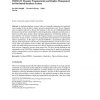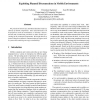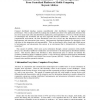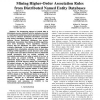DPD
2010
14 years 2 months ago
2010
In distributed database systems, tables are frequently fragmented and replicated over a number of sites in order to reduce network communication costs. How to fragment, when to rep...
IJCAI
2007
14 years 6 months ago
2007
In this paper we present an improved version of the Probabilistic Ant based Clustering Algorithm for Distributed Databases (PACE). The most important feature of this algorithm is ...
CIKM
2008
Springer
14 years 6 months ago
2008
Springer
In a number of application areas, distributed database systems can be used to provide persistent storage of data while providing efficient access for both local and remote data. W...
WER
2000
Springer
14 years 8 months ago
2000
Springer
Distributed database design is a complex process that involves a set of distinct aspects for the accomplishment of an adequate data distribution (Buretta 1997). Many of these aspec...
ERSHOV
1993
Springer
14 years 8 months ago
1993
Springer
Distributed database applications are a wide use of distributed systems. One of the major advantages of distributed database systems is the potential for achieving high availabili...
RIDE
2000
IEEE
14 years 9 months ago
2000
IEEE
We present the notion of a distributed database made up entirely of mobile components. Since disconnections will be frequent in such an environment, we develop a disconnection and...
AI
2004
Springer
14 years 10 months ago
2004
Springer
To address the of mining a huge volume of geographically distributed databases, we propose two approaches. The first one is to download only a sample of each database. The second ...
ISSADS
2005
Springer
14 years 10 months ago
2005
Springer
Classical distributed database systems monolithically offer distribution transparency and higher performance. This is made possible by making data available and closer to the appl...
ISI
2007
Springer
14 years 10 months ago
2007
Springer
The burgeoning amount of textual data in distributed sources combined with the obstacles involved in creating and maintaining central repositories motivates the need for effective ...




